Bayesian-Based Approach for the Thermographic Measurement of Flow Transition on Wind Turbine Rotor Blades
Abstract
:1. Introduction
1.1. Motivation
1.2. State of the Art
1.3. Aim and Outline
2. Materials and Methods
2.1. Thermographic Visualization of Steady Flow Behavior
2.2. The Bayesian Approach
3. Experimental Setup
3.1. Measurement Object
3.2. Measurement System
- The wind speed must be permanently between the switch-on and switch-off speed of the turbine. In addition, operation in the part-load range is desirable, since in part-load operation there is a linear dependence between the wind speed and the rotor speed and thus the optical detection of the rotor speed allows an approximation of the incident flow speed [31].
- The solar heating of the rotor blades is constant in time.
- For a fixed geometric alignment between the camera and the observed rotor blade section, no yawing or pitching may occur during the measurement period.
3.3. Signal Processing
- Background removal and outlier removal.
- Detection of the rotor blade edges with Canny edge detection [32].
- Assignment of the edges (leading, trailing) via clustering and standard deviation within a cluster.
- Horizontal alignment of the leading edge by means of image rotation.
- Compensation of the interpolation effects on the image edges due to image rotation.
4. Results
4.1. Verification of the Bayesian Approach
4.2. Validation of the Bayesian Approach
4.3. Application Scenarios and Suitable Priors
5. Conclusions
Author Contributions
Funding
Institutional Review Board Statement
Informed Consent Statement
Data Availability Statement
Conflicts of Interest
References
- Schlichting, H.; Gersten, K. Grenzschicht-Theorie: Mit…22 Tabellen; 10., Überarb. Aufl; Springer: Berlin/Heidelberg, Germany, 2006. [Google Scholar]
- Schaffarczyk, A.P.; Schwab, D.; Breuer, M. Experimental detection of laminar-turbulent transition on a rotating wind turbine blade in the free atmosphere. Wind Energy 2016, 20, 211–220. [Google Scholar] [CrossRef]
- Meyers, J.F. Development of Doppler global velocimetry as a flow diagnostics tool. Meas. Sci. Technol. 1995, 6, 769–783. [Google Scholar] [CrossRef]
- Fischer, A. Model-based review of Doppler global velocimetry techniques with laser frequency modulation. Opt. Lasers Eng. 2017, 93, 19–35. [Google Scholar] [CrossRef]
- Kompenhans, J.; Reichmuth, J. 2-D flow field measurements in wind tunnels by means of particle image velocimetry. In International Congress on Applications of Lasers & Electro-Optics; Laser Institute of America: San Diego, CA, USA, 1987; pp. 119–126. [Google Scholar] [CrossRef]
- Gartenberg, E.; Roberts, A.S. Airfoil Transition and Separation Studies Using an Infrared Imaging System. J. Aircr. 1991, 28, 225–230. Available online: https://ntrs.nasa.gov/citations/19910055592 (accessed on 26 April 2023). [CrossRef]
- Montelpare, S.; Ricci, R. A thermographic method to evaluate the local boundary layer separation phenomena on aerodynamic bodies operating at low Reynolds number. Int. J. Therm. Sci. 2004, 43, 315–329. [Google Scholar] [CrossRef]
- Gartenberg, E.; Roberts, A.S., Jr.; McRee, G.J. Infrared imaging and tufts studies of boundary layer flow regimes on a NACA 0012 airfoil. In ICIASF 1989—13th International Congress on Instrumentation in Aerospace Simulation Facilities; IEEE: Piscataway, NJ, USA, 1989; pp. 168–178. [Google Scholar]
- Gazzini, S.L.; Schädler, R.; Kalfas, A.I.; Abhari, R.S. Infrared thermography with non-uniform heat flux boundary conditions on the rotor endwall of an axial turbine. Meas. Sci. Technol. 2016, 28, 025901. [Google Scholar] [CrossRef]
- Von Hoesslin, S.; Stadlbauer, M.; Gruendmayer, J.; Kähler, C.J. Temperature decline thermography for laminar–turbulent transition detection in aerodynamics. Exp. Fluids 2017, 58, 129. [Google Scholar] [CrossRef]
- Horstmann, K.H.; Quast, A.; Redeker, G. Flight and wind-tunnel investigations on boundary-layer transition. J. Aircr. 1990, 27, 146–150. [Google Scholar] [CrossRef]
- Dollinger, C.; Sorg, M.; Balaresque, N.; Fischer, A. Measurement uncertainty of IR thermographic flow visualization measurements for transition detection on wind turbines in operation. Exp. Therm. Fluid Sci. 2018, 97, 279–289. [Google Scholar] [CrossRef]
- Reichstein, T.; Schaffarczyk, A.P.; Dollinger, C.; Balaresque, N.; Schülein, E.; Jauch, C.; Fischer, A. Investigation of Laminar–Turbulent Transition on a Rotating Wind-Turbine Blade of Multimegawatt Class with Thermography and Microphone Array. Energies 2019, 12, 2102. [Google Scholar] [CrossRef]
- Oehme, F.; Gleichauf, D.; Suhr, J.; Balaresque, N.; Sorg, M.; Fischer, A. Thermographic detection of turbulent flow separation on rotor blades of wind turbines in operation. J. Wind. Eng. Ind. Aerodyn. 2022, 226, 105025. [Google Scholar] [CrossRef]
- Oehme, F.; Gleichauf, D.; Balaresque, N.; Sorg, M.; Fischer, A. Thermographic detection and localisation of unsteady flow separation on rotor blades of wind turbines. Front. Energy Res. 2022, 10, 1043065. [Google Scholar] [CrossRef]
- Raffel, M.; Merz, C.B. Differential Infrared Thermography for Unsteady Boundary-Layer Transition Measurements. AIAA J. 2014, 52, 2090–2093. [Google Scholar] [CrossRef]
- Gleichauf, D.; Oehme, F.; Parrey, A.-M.; Sorg, M.; Balaresque, N.; Fischer, A. On-site contactless visualization of the laminar-turbulent flow transition dynamics on wind turbines. tm Tech. Mess. 2023, 90, 9. [Google Scholar] [CrossRef]
- Gleichauf, D.; Dollinger, C.; Balaresque, N.; Gardner, A.D.; Sorg, M.; Fischer, A. Thermographic flow visualization by means of non-negative matrix factorization. Int. J. Heat Fluid Flow 2020, 82, 108528. [Google Scholar] [CrossRef]
- Gleichauf, D.; Oehme, F.; Sorg, M.; Fischer, A. Laminar-Turbulent Transition Localization in Thermographic Flow Visualization by Means of Principal Component Analysis. Appl. Sci. 2021, 11, 5471. [Google Scholar] [CrossRef]
- Mohammady, M.H.; Miyadera, T. Quantum measurements constrained by the third law of thermodynamics. Phys. Rev. A 2023, 107, 022406. [Google Scholar] [CrossRef]
- Bayes, T.; Price, R. LII. An essay towards solving a problem in the doctrine of chances. By the late Rev. Mr. Bayes, F. R. S. communicated by Mr. Price, in a letter to John Canton, A. M. F. R. S. Phil. Trans. R. Soc. 1763, 53, 370–418. [Google Scholar] [CrossRef]
- Gelfand, A.E.; Smith, A.F.M. Sampling-Based Approaches to Calculating Marginal Densities. J. Am. Stat. Assoc. 1990, 85, 398–409. [Google Scholar] [CrossRef]
- Meija, J.; Bodnar, O.; Possolo, A. Ode to Bayesian methods in metrology. Metrologia 2023, 60, 052001. [Google Scholar] [CrossRef]
- Kruschke, J.K. Bayesian Assessment of Null Values Via Parameter Estimation and Model Comparison. Perspect. Psychol. Sci. 2011, 6, 299–312. [Google Scholar] [CrossRef] [PubMed]
- Attivissimo, F.; Giaquinto, N.; Savino, M. Some Thoughts About the Frequentist and the Bayesian Approach to Uncertainty. In Proceedings of the XVIII IMEKO TC-4 Symposium, Natal, Brazil, 27–30 September 2011. [Google Scholar]
- Lira, I.; Grientschnig, D. Bayesian assessment of uncertainty in metrology: A tutorial. Metrologia 2010, 47, R1–R14. [Google Scholar] [CrossRef]
- Cowen, S.E.; Wilson, P.; Pennecchi, F.; Kok, G.; van der Veen, A.; Pendrill, L. A Guide to Bayesian Inference for Regression Problems; PTB: Braunschweig, Germany, 2015. [Google Scholar]
- Gilks, W.; Richardson, S.; Spiegelhalter, D. Introducing Markov Chain Monte Carlo; CRC Press: Boca Raton, FL, USA, 1996. [Google Scholar]
- University of Maryland. Change of Random Variables. Available online: https://www.math.umd.edu/~millson/teaching/STAT400fall18/handouts/changeofvariable.pdf (accessed on 28 April 2023).
- Weir, M.D.; Hass, J.; Thomas, G.B. Thomas’ Calculus: Early Transcendentals, 13th ed.; Pearson: Boston, MA, USA, 2014. [Google Scholar]
- Halyani, M.Y.; Firdaus, H.M.S.; Azizi, M.S.; Tajul, A.; Farhana, R.F. Modeling and Simulation of Wind Turbine for Partial Load Operation. ARPN J. Eng. Appl. Sci. 2016, 11, 4934–4941. [Google Scholar]
- Canny, J. A Computational Approach to Edge Detection. IEEE Trans. Pattern Anal. Mach. Intell. 1986, 8, 679–698. [Google Scholar] [CrossRef]
- Kay, S.M.; Kay, S.M. Fundamentals of Statistical Signal Processing. 1: Estimation Theory; 20. Pr; Prentice Hall PTR: Upper Saddle River, NJ, USA, 2013. [Google Scholar]

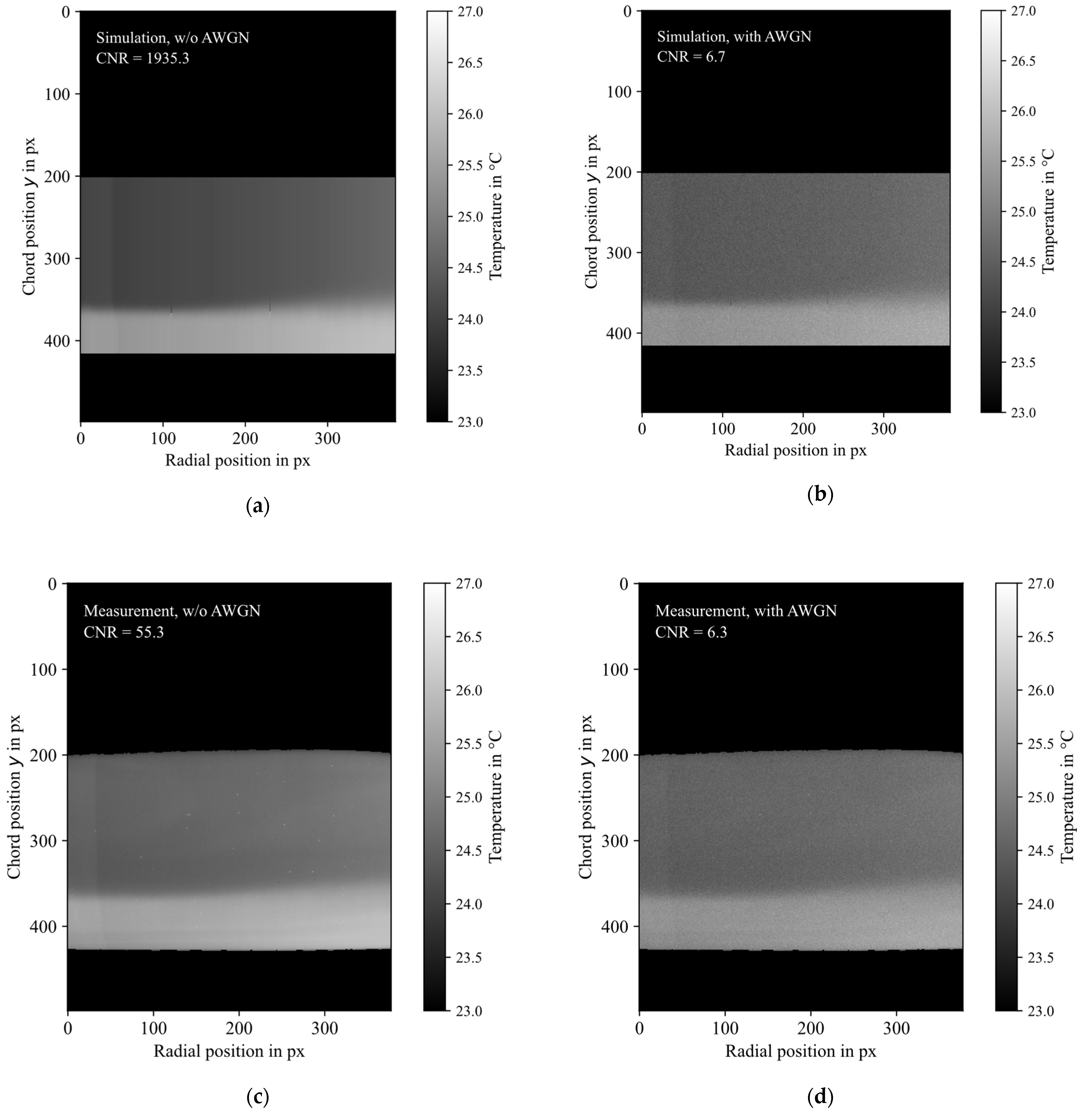
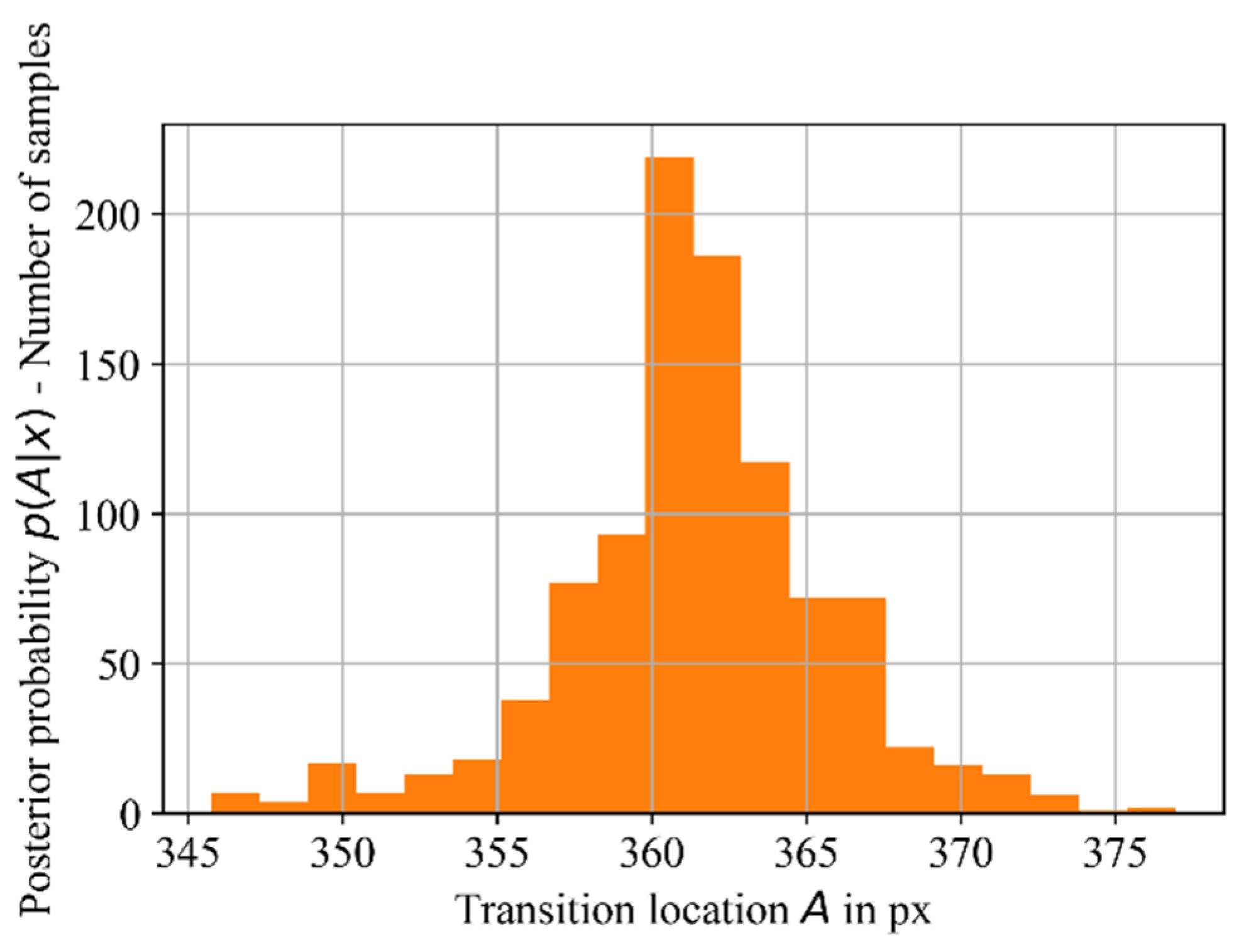
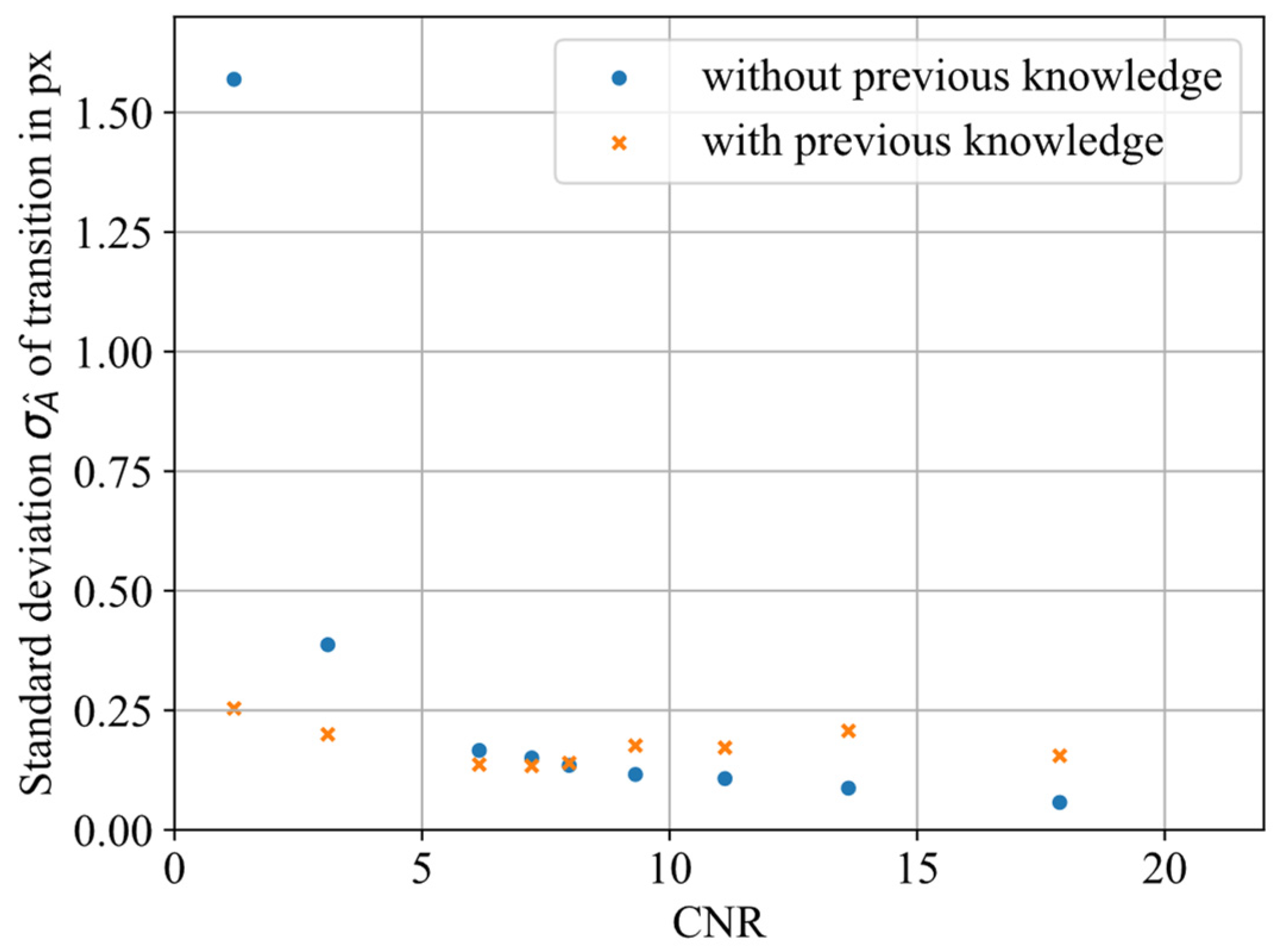


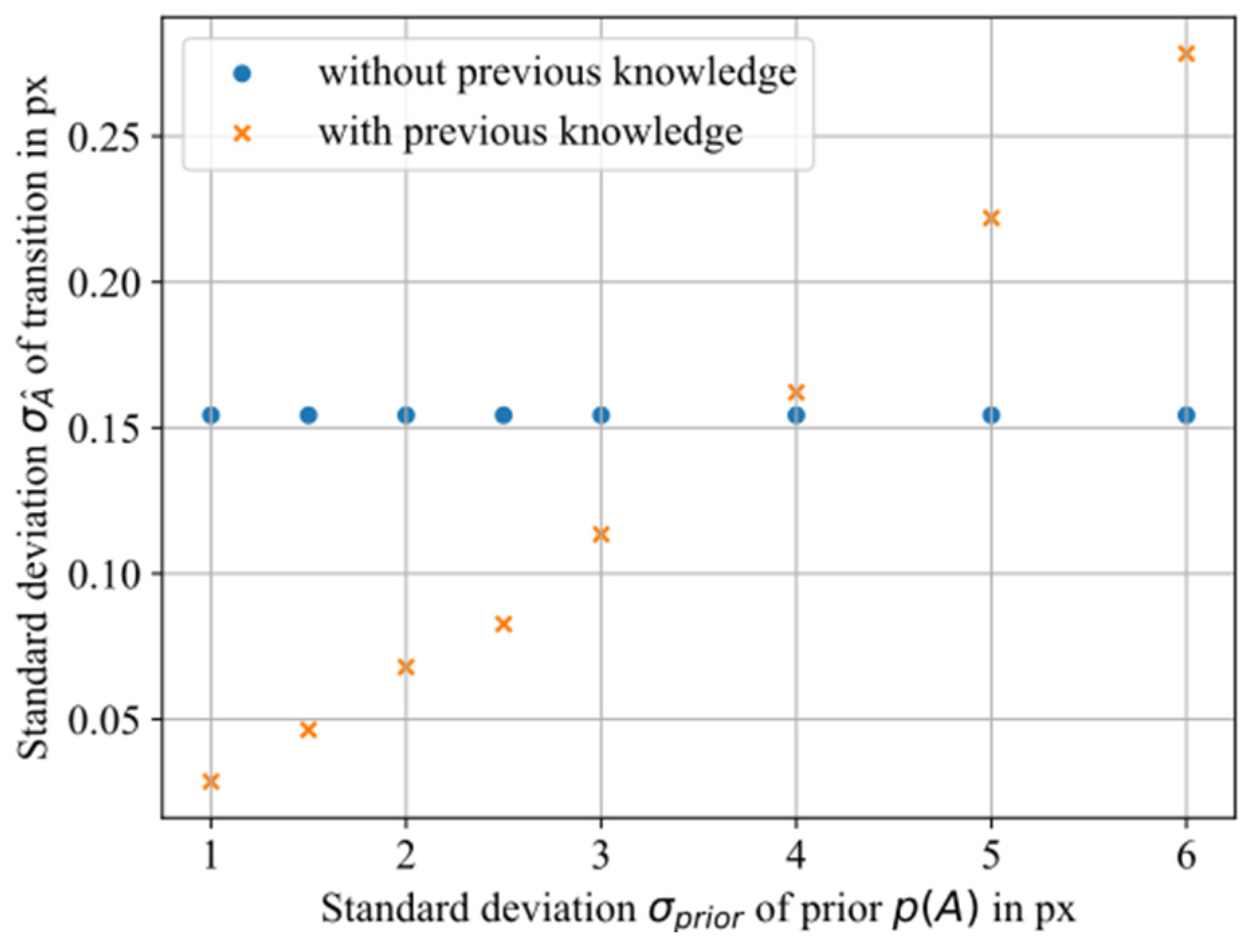
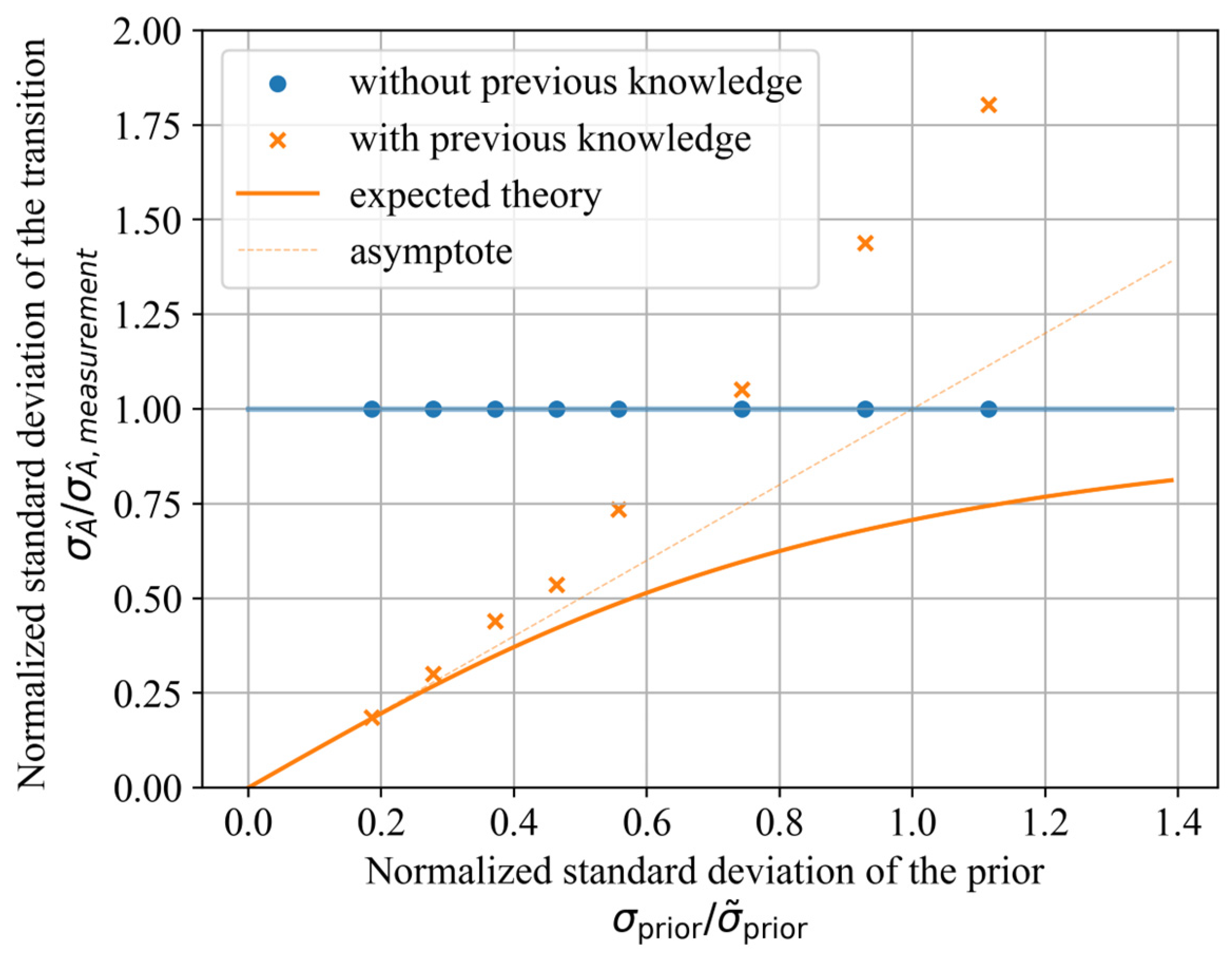


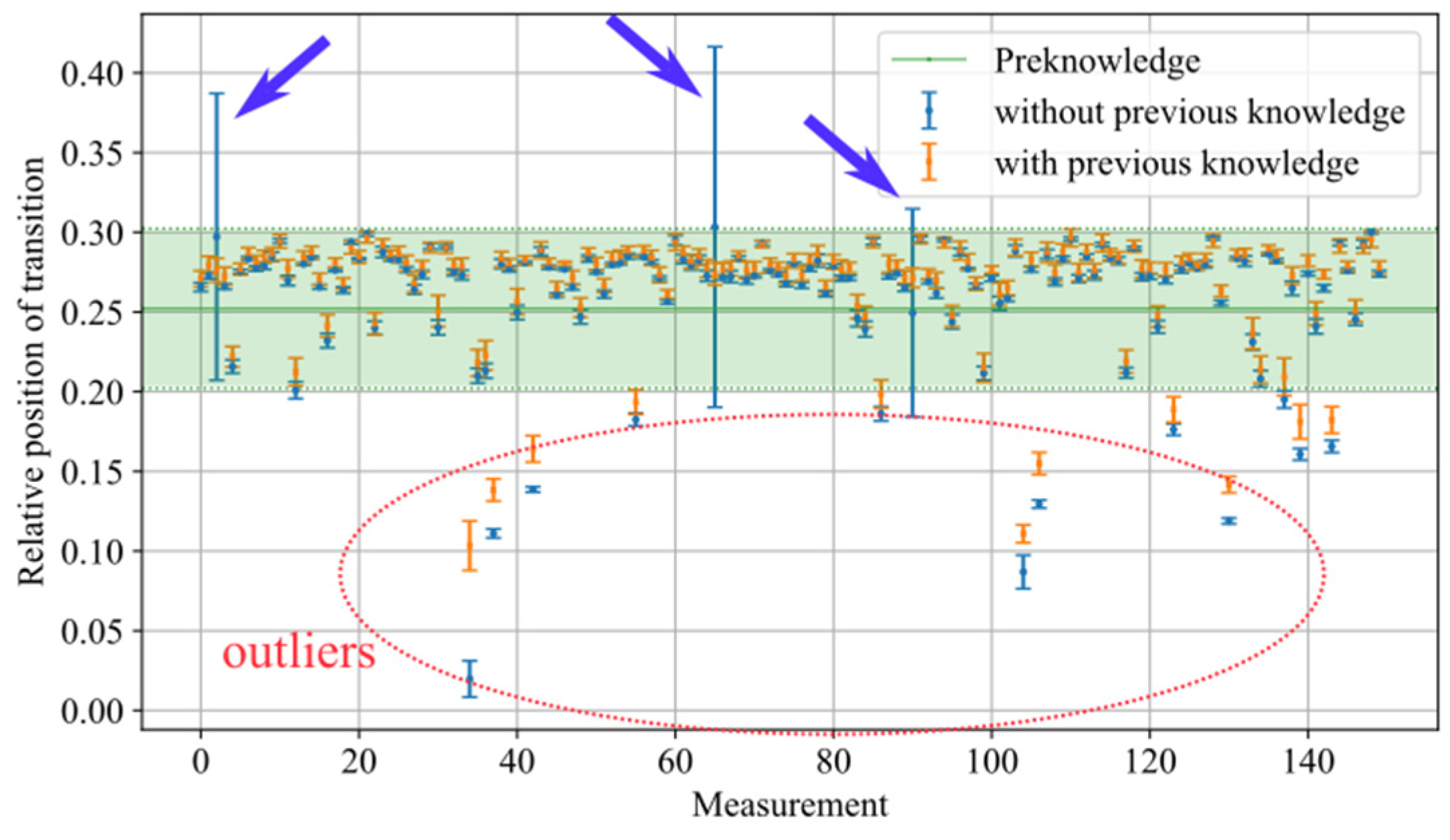
| Classical Estimation | Bayesian Estimation | |||
|---|---|---|---|---|
| Least Squares Estimation (LSE) [12] | Principal Component Analysis and LSE [19] | Spatial Previous Knowledge | Temporal Previous Knowledge | |
| Previous knowledge is taken into account | No | No | Yes | Yes |
| Preconditions | None | Image time series | 2D measurement (image) under spatially smooth/steady conditions | Time series measurement, under temporally smooth/steady conditions |
| Obtaining a measure of the measurement uncertainty | Explicit | Explicit | Implicit | Implicit |
| Measurement uncertainty | Depends on CNR | ~5% smaller than with LSE | Smaller than with LSE, but may introduce a systematic error | Reduces uncertainty on falsely detected transition positions, but introduces an error on correctly detected transition positions |
| Spatio-temporal resolution | Full resolution | Reduced temporal resolution due to averaging artefacts | Full resolution | Full resolution |
Disclaimer/Publisher’s Note: The statements, opinions and data contained in all publications are solely those of the individual author(s) and contributor(s) and not of MDPI and/or the editor(s). MDPI and/or the editor(s) disclaim responsibility for any injury to people or property resulting from any ideas, methods, instructions or products referred to in the content. |
© 2024 by the authors. Licensee MDPI, Basel, Switzerland. This article is an open access article distributed under the terms and conditions of the Creative Commons Attribution (CC BY) license (https://creativecommons.org/licenses/by/4.0/).
Share and Cite
Dieckmann, J.; Dorszewski, C.; Balaresque, N.; von Freyberg, A.; Fischer, A. Bayesian-Based Approach for the Thermographic Measurement of Flow Transition on Wind Turbine Rotor Blades. Appl. Sci. 2024, 14, 1166. https://doi.org/10.3390/app14031166
Dieckmann J, Dorszewski C, Balaresque N, von Freyberg A, Fischer A. Bayesian-Based Approach for the Thermographic Measurement of Flow Transition on Wind Turbine Rotor Blades. Applied Sciences. 2024; 14(3):1166. https://doi.org/10.3390/app14031166
Chicago/Turabian StyleDieckmann, Jakob, Caroline Dorszewski, Nicholas Balaresque, Axel von Freyberg, and Andreas Fischer. 2024. "Bayesian-Based Approach for the Thermographic Measurement of Flow Transition on Wind Turbine Rotor Blades" Applied Sciences 14, no. 3: 1166. https://doi.org/10.3390/app14031166





